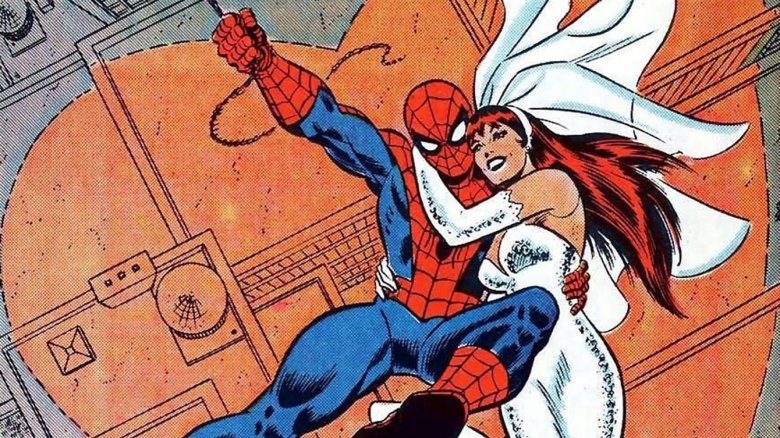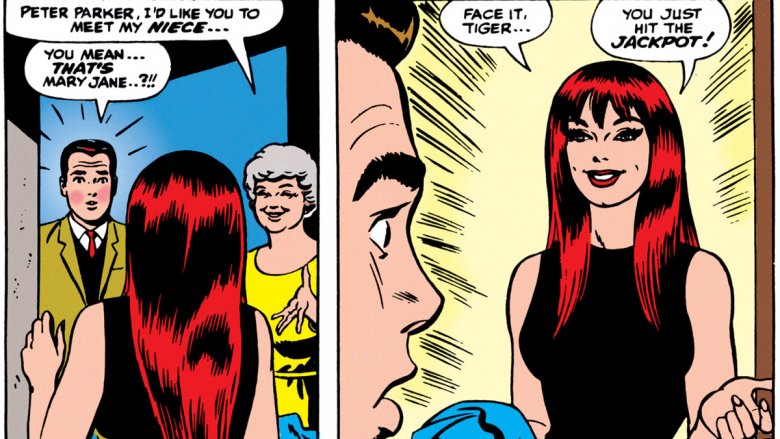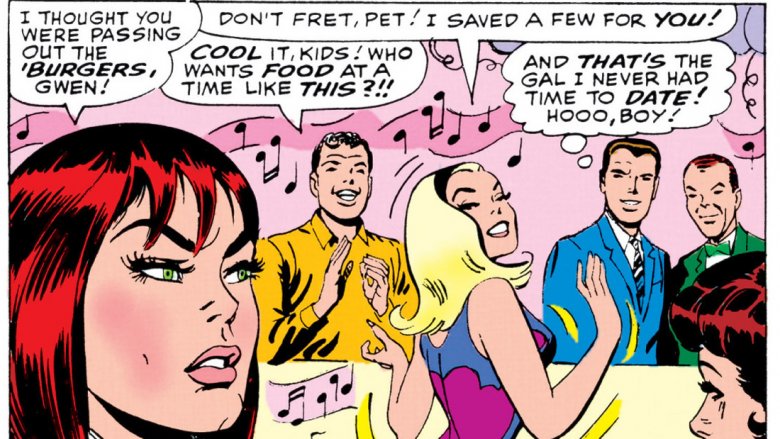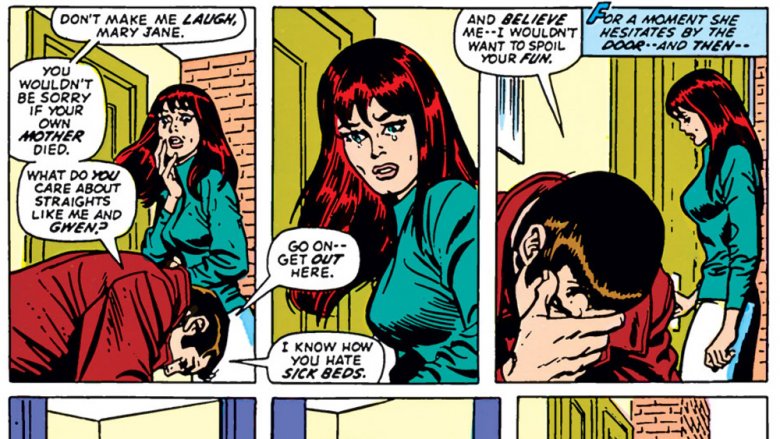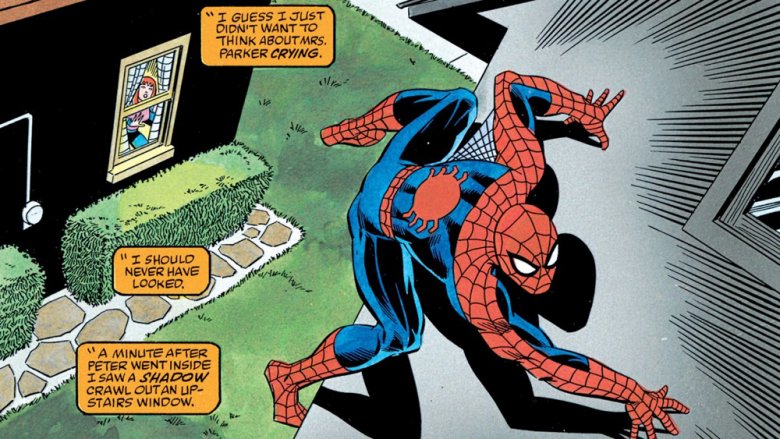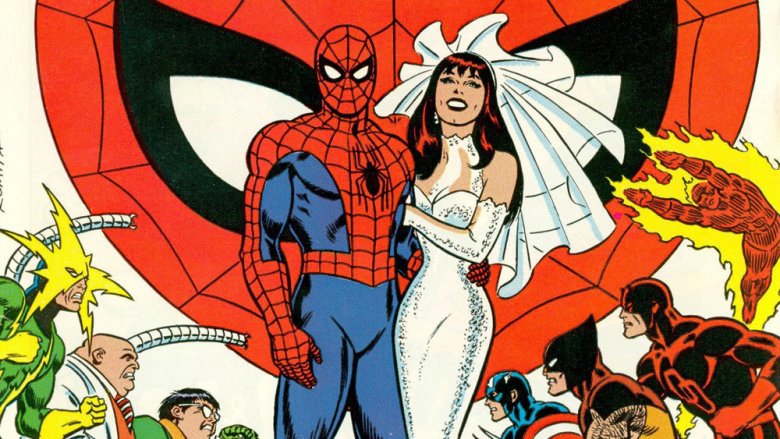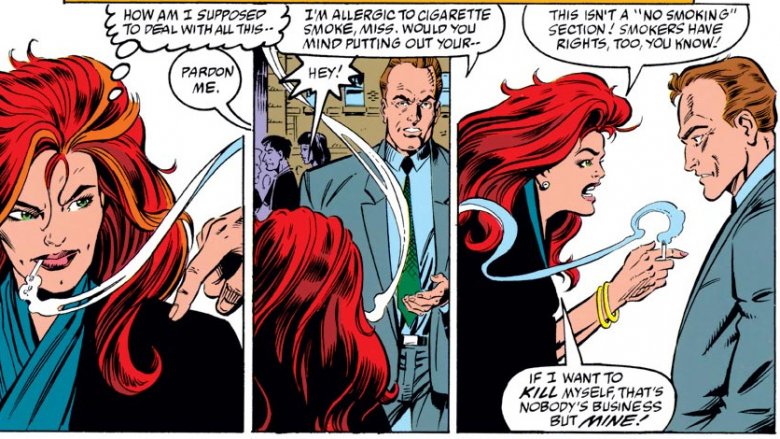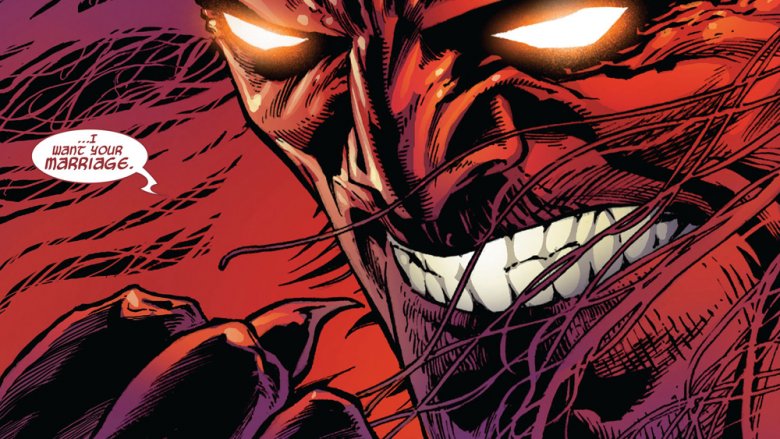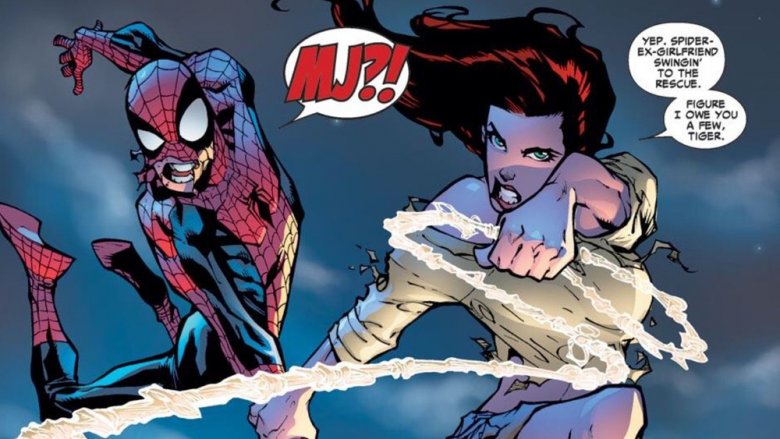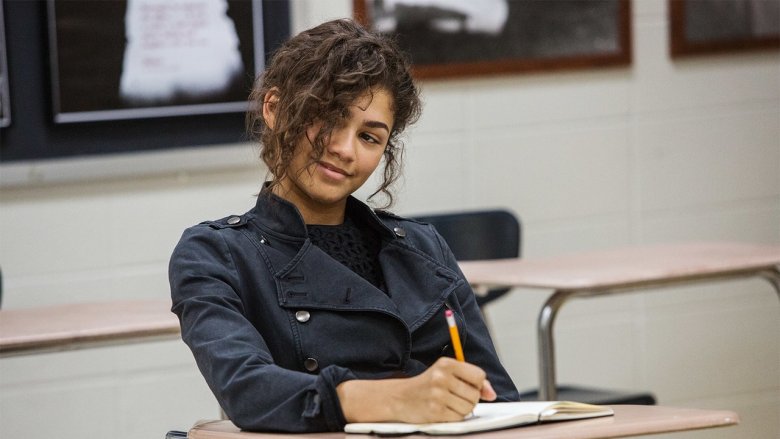The Untold Truth Of Mary Jane Watson
Over the last seven decades, the superheroic saga of the amazing Spider-Man has featured a whole lot of love interests for everybody's favorite web-slinger, including master thief Black Cat, the late Gwen Stacy, and derby girl/forensic scientist Carlie Cooper. For all his bad luck, Peter Parker's life has never been short on romance, but face it, tiger: None of those characters have had the staying power or importance of Mary Jane Watson.
Originally introduced in 1966 in one of the most memorable moments in Spider-Man history, Mary Jane has had a career on the page that's almost as complicated as her radioactive paramour's. She's been a flighty party girl with a surprising secret, a supermodel with a melodramatic habit, and she once made a deal with the Devil himself, and that's just scratching the surface. From her comic book origins to her on-screen adaptations, here's the surprisingly complicated truth behind Mary Jane Watson.
Mary Jane was the (literal) girl next door
While she wouldn't make her full appearance until December 1966, Mary Jane was first mentioned way back in Amazing Spider-Man #15. For over two years, she was actually a running gag in the comic, with Aunt May constantly trying to wrangle Peter into a blind date with the niece of her next-door neighbor, and Peter making every excuse that he could to duck out and avoid actually meeting her. The joke, of course, was that Peter assumed anyone who needed their aged aunt to set them up on a blind date was, to put it charitably, probably not the most desirable person for a relationship.
Then came Amazing Spider-Man #42, from Stan Lee and John Romita Sr. After months of Anna Watson's niece being mentioned and occasionally glimpsed in shadows or obscured by furniture — and after a relatively forgettable fight between Spider-Man and hero astronaut John Jameson — Mary Jane Watson made her first full appearance, and we finally got the punchline. It turned out that MJ was actually hot.
Putting aside the dubious moral lesson about keeping an open mind because people you haven't met might be physically attractive, this was just one of the few times in the entire decade that Aunt May was right about something. And more importantly, Mary Jane's appearance marked a huge shift in the Spider-Man dynamic.
She made Spider-Man's love life incredibly difficult
For the first few years of her existence, Mary Jane's major effect on the Amazing Spider-Man comics was to convert a love triangle into something that looked a little more like a rhombus — maybe even a pentagram if you throw Flash Thompson in there for good measure. She was pitted against Gwen Stacy, Peter Parker's long-established dream girl, competing for Peter's affection, and occasionally settling for double dates with Peter's roommate (and future Green Goblin), Harry Osborn.
Gwen, for her part, had been introduced way back in the early days by Spider-Man's co-creators, Stan Lee and Steve Ditko. In her original appearances, Gwen was a very different sort of love interest — a brilliant science student with a short temper who often found herself bickering with Peter and trading sharp quips as their romantic tension grew.
All that changed with Ditko's departure from the book after months of being at odds with Lee. The two creators disagreed over whether they should reveal the Green Goblin to be Norman Osborn, and Ditko got so frustrated that he eventually walked away. So Romita stepped in as Ditko's replacement and arguably became the definitive artist of the era. The main change came from bringing his experience from doing romance comics at DC, and he transformed Peter from an awkward, angular teenager to a handsome college student. Romita also applied the same style to the rest of the cast. Gwen started spending a lot of time in go-go boots and minidresses, and MJ, the consummate party girl, played right into that aesthetic ... right up until the Green Goblin changed Spidey's supporting cast forever.
Gwen goes, Mary Jane stays
Amazing Spider-Man #121 will live in infamy for being, as the title of the issue revealed on its very last page, "The Night Gwen Stacy Died." If you're even passingly familiar with Spider-Man's history, you know how this one goes: After discovering Spidey's secret identity, the Green Goblin kidnaps Gwen and winds up tossing her off of the George Washington Bridge. And when Spider-Man snags her with a web-line in an attempt to save her life, he accidentally snaps her neck.
It was a huge shift for the Spider-Man saga, and it remains one of the most important deaths in Marvel Comics history (and along with Uncle Ben's, it's one of the few that's been carved into stone and never undone). What's often overlooked, though, is that the issue that followed represented a change that was almost as big, and not just because the Goblin himself "died."
After Gwen's death, Mary Jane shows up at Peter's apartment, and in his grief, Peter snaps at her, offering up some extremely harsh comments about MJ's seemingly shallow, uncaring, party-girl personality. When he tells her to leave, though, Mary Jane pauses and closes the door, choosing to stay with Peter, forgive him for what he said, and help him through the tragedy. It was the first sign readers got that MJ was a little deeper than we'd been led to believe, and it also hinted at a major reveal that wouldn't hit the page for another 16 years.
Parallel Lives and secret identities
In 1989, Marvel published Amazing Spider-Man: Parallel Lives, an oversized graphic novel from artist Alex Saviuk and long-time Spider-Man writer Gerry Conway, the guy who'd been given the book when Stan Lee departed and, among other things, wrote "The Night Gwen Stacy Died" and co-created the Punisher. As the title suggests, the book focuses on Peter and Mary Jane as they grow up, and the ways their lives intersect.
This particular story reveals that Mary Jane had taken a keen interest in Spider-Man from the very beginning. Her fascination only increased on the night that Ben Parker was shot, when she looked out the window of her aunt's house and saw Spider-Man climbing out of her neighbor's window. She immediately realized that Peter Parker was Spider-Man, and comic book fans suddenly realized that MJ had always known about his secret identity — even before readers were introduced to her — which changed everything.
Instead of being the blind date that Aunt May and Anna Watson had worked so hard to set up, Mary Jane was recontextualized as someone who'd asked for an introduction to Peter and pursued him through the early days of their relationship. It wasn't because of a misguided obsession with Spidey, or because she had a thing for superheroes. Instead, it was because she'd found a parallel (get it?) between the way he wore a mask and kept his heroic identity separate from the tragedies of his personal life and the way that she had always affected that flighty, shallow persona to mask the trauma of her abusive upbringing. More than anything else, the idea that she'd kept Peter's identity a secret for years without him even knowing it put her in a completely different class than any other love interest in Spider-Man history.
Mary Jane Watson and the wedding of the century
In a lot of ways, the Spider-Man saga is about watching Peter Parker grow up. He starts his superheroic career as a high school student who lets his bitterness at being a social outcast cause him to give into selfishness, and then he has to deal with the consequences of those actions. Over the next few years, readers saw him stand up to a bully, get a job, graduate from high school, deal with college drama, and face all the other milestones that most folks go through, even if they don't fight Doctor Octopus and the Lizard in between.
In 1987, Peter and Mary Jane reached the next big life milestone together when they were married on the steps of New York City Hall in Amazing Spider-Man Annual #21. The thing is, it almost didn't happen, at least in the context of the story. By the late '80s, Peter and MJ had been through an on-again, off-again relationship that had seen the stress of Peter's life as Spider-Man causing plenty of problems. Even once they realized they wanted to be married, and even after Peter proposed twice, they both still had a lot of doubts. That was what made ASM Annual #21 such an interesting comic. Plenty of superhero weddings feature villains showing up, but this story was focused on Peter trying to decide if he should break things off, with MJ herself being tempted to run away with a famous actor. In the end, of course, they two got hitched in the ultimate superhero wedding.
As for the real-world motivations behind the wedding, Stan Lee claimed credit for suggesting both the wedding itself and the idea of doing it in the ongoing comic book and the newspaper comic strip at the same time as a publicity stunt. The strip's version of the marriage was dedicated to fashion designer Willi Smith, who created Mary Jane's wedding dress and appeared in the Annual. Sadly, he would die of AIDS-related illness at the age of 39, shortly before the issue was published.
Mary Jane was a smoker?
While she's been very important to the comics over the years, Mary Jane has mostly been relegated to the status of a supporting character. There was, however, one pretty spectacular, long-running story which put Mary Jane in the spotlight: the extended saga of Mary Jane Watson-Parker ... versus cigarettes.
Look, smoking is bad. It's terrible for your health, it costs way too much money, and it's off-putting for nonsmokers around you. It's also obvious that kids look up to their favorite comic book characters and can learn valuable lessons from them. That's why there are so many PSA comics where Batman tells us not to do drugs, or where Superman says that littering is bad. That said, even the most die-hard anti-smoking devotee would have to admit this particular attempt at saying tobacco is whacko was hilariously melodramatic at best.
The story ran from Amazing Spider-Man #361 to #384, and kicked off with Mary Jane confessing that the stress of being married to Spider-Man had led her to start smoking again, after picking up the habit "when I was a kid, you know, to be 'cool'?" For months, MJ found that her bad habit was ruining her life, from Spider-Man begging her to quit to almost getting fired from her role on a soap opera because she wouldn't stop smoking when she was on set. Hilariously, all of this happened at the same time that Spider-Man was fighting Carnage, a maniac serial killer who had bonded with a symbiote that made him even deadlier than Venom. Eventually, after yelling at a dude who told her he was "allergic to cigarette smoke," she kicked the habit, and that was that.
Wedding? What wedding?
For years, it was rumored that higher-ups at Marvel Comics wanted to get rid of Mary Jane and Peter's marriage due to worries about it making him seem old. The problem was that they didn't want to be stuck with a Spider-Man who'd been widowed or divorced, which would make him seem even older (and wouldn't really work until Into the Spider-Verse). Eventually, though, they hit on the solution: Just have somebody make a deal with the devil.
No, really!
It happened in the aftermath of Civil War, a crossover that, among other things, had Spider-Man publicly reveal his secret identity, which immediately led to Aunt May getting shot by a hitman. In order to save Aunt May and put the "secret" back into Peter's secret identity, Peter and MJ essentially sold their marriage to Mephisto, the Marvel Universe's most stalwart stand-in for Satan, in a story called "One More Day."
The second weirdest thing about this — other than the part where Spider-Man and his wife were making Faustian bargains — was that it didn't really disrupt continuity all that much. The official company line was that every Spider-Man story that had taken place during the married years had still happened. The only thing that had been retroactively changed was the wedding itself. The post-"One More Day" idea was that all of the couples' previous doubts had actually gotten to them, and while they'd kept on living together, they just never tied the knot.
The weirdest thing was that, just as it had with the wedding, the newspaper strip attempted to follow the comics continuity, just without all the stuff about the devil. But newspaper comic strip readers hate those kind of changes even more than regular comics readers do, and the reaction was so bad that the new storyline only lasted a short time before it was all re-retconned into just being a weird dream. In the newspapers, Spider-Man and MJ are still happily married.
For the most part, Mary Jane has never had powers
If you're less than four degrees of separation away from Peter Parker, the odds are pretty good that you've been a superhero, a supervillain, or both at some point in your life. His college roommate became the Green Goblin, and his science teacher was the Jackal. A coworker became Venom, two other coworkers were both the Hobgoblin at various times, and his boss' son was a space werewolf. Even Aunt May was once taken into space and reborn as Golden Oldie, Herald of Galactus.
The one big exception? Mary Jane Watson. Despite being in close proximity to Spider-Man for over 50 years of real-time comics, MJ never got any super-powers of her own. The only big exception came during the events of the "Spider-Island" crossover, but considering that everyone in Manhattan briefly got Spider-Man powers during that story, that doesn't really count.
There was, however, an issue of Marvel Team-Up back in the late '70s where MJ was briefly possessed by the spirit of Red Sonja, who was brought forward in time to fight an evil wizard. Really, though, that's just a pretty normal Tuesday for the Marvel Universe.
MJ at the movies
Given her prominence in the comics, it's no surprise that out of the three big-screen versions of the Spider-Man story that have hit the big screen since 2002, Mary Jane Watson has appeared in two of them ... sort of. (She's completely absent in the two Amazing Spider-Man films from 2012 and 2014, with Emma Stone as Gwen Stacy serving as the love interest in those films.)
In the Spider-Man trilogy directed by Sam Raimi, MJ is one of the most prominent characters. Kirsten Dunst co-starred in all three films, and her version of Mary Jane provided most of the non-superhero drama, from Peter's sad decision to keep his identity secret in the first movie all the way to their relationship difficulties in the third film — exacerbated, of course, by an alien symbiote that drove Peter to stage one of cinema's most mean-spirited dance numbers. Unfortunately, all that drama led to some criticism of the character for being needlessly harsh towards her city-saving boyfriend.
MJ has also appeared in the MCU Spider-Man films, in a way. Peter's main love interest in those, particularly in Far From Home, is Michelle, played by Zendaya. It's not until the end of Spider-Man: Homecoming that viewers learn her full name is Michelle Jones, and that her friends call her MJ. This MJ is very different from what we've seen in the comics — instead of Mary Jane Watson's party-girl persona that was born in the swingin' '60s, Michelle is a little more in line with the kids of today, thanks to her interests in true crime and sarcasm — but those initials are definitely not a coincidence.
